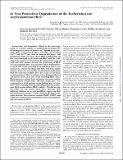| dc.contributor.author | Guzman-Verri, Caterina | |
| dc.contributor.author | Chaves-Olarte, Esteban | |
| dc.contributor.author | García, Fernando | |
| dc.contributor.author | Arvidson, Staffan | |
| dc.contributor.author | Moreno, Edgardo | |
| dc.date.accessioned | 2020-10-28T17:21:31Z | |
| dc.date.available | 2020-10-28T17:21:31Z | |
| dc.date.issued | 2001-05-18 | |
| dc.identifier.uri | http://hdl.handle.net/11056/18460 | |
| dc.description.abstract | Escherichia coli hemolysin (HlyA) is the prototype toxin of a major family of exoproteins produced by Gram-negative bacteria known as “repeats in toxins.” Only fatty acid-acylated HlyA molecules at residues Lys564 and Lys690 are able to damage the target cell membrane. Fatty acylation of pro-HlyA is dependent on the co-synthesized acyltransferase HlyC and the acylated form of acyl-carrier protein. By using a collection of hlyA and hlyC mutant strains, the processing of HlyC was investigated. HlyC was not detected by Western blot in an E. coli strain encoding hlyC and hlyA, but it was present in a strain encoding only hlyC. The hlyC mRNA pattern, however, was similar in both strains indicating that the turnover of HlyC does not occur at the transcriptional level. HlyC was detected in Western blots of cell lysates from an E. coli strain encoding HlyC and a HlyA derivative where both acylation sites were substituted. Similar results were obtained when HlyC was expressed in a hlyA mutant strain lacking part of a putative HlyC binding domain, indicating that this particular HlyA region affects HlyC stability. We did not detect HlyC in cell lysates from hlyC mutants with different abilities to acylate pro-HlyA, suggesting that the degradation of HlyC is not related to the HlyA acylation process. The protease systems ClpAP, ClpXP, and FtsH were found to be responsible for the HlyA-dependent processing of HlyC. | es_ES |
| dc.description.abstract | La hemolisina de Escherichia coli (HlyA) es el prototipo de una importante familia de exoproteínas producidas por Bacterias Gram-negativas conocidas como "repeticiones en las toxinas". Sólo las moléculas de HlyA con ácidos grasos en los residuos Lys564 y Lys690 son capaces de dañar la célula objetivo membrana. La acilación grasa de pro-HlyA depende de la HlyC de la aciltransferasa co-sintetizada y la forma aciliada de la proteína portadora de acil. Al utilizar una colección de cepas mutantes de HlyA y HlyC, el procesamiento de HlyC fue investigado. El HlyC no fue detectado por Western blot en una cepa de E. coli que codifica hlyC y hlyA, pero fue presente en una cepa que sólo codifica el HlyC. El ARNm de hlyC Sin embargo, la pauta fue similar en ambas cepas, lo que indica que que la rotación de HlyC no se produce a nivel de transcripción. El HlyC fue detectado en manchas occidentales de lisados celulares de una cepa de E. coli que codifica HlyC y un Derivado de HlyA en el que se sustituyeron ambos sitios de acilación. Se obtuvieron resultados similares cuando HlyC fue expresada en una cepa mutante de HlyA que carece de parte de un supuesto dominio vinculante de HlyC, lo que indica que esta región particular de HlyA afecta a la estabilidad de HlyC. No detectamos HlyC en los lisados celulares de los mutantes de HlyC con diferentes habilidades para aciliar pro-HlyA, lo que sugiere que la degradación de HlyC no está relacionada con el proceso de acylación de HlyA. Los sistemas de proteasa ClpAP, ClpXP y se encontró que FtsH era responsable del procesamiento dependiente de HlyA de HlyC. | es_ES |
| dc.description.sponsorship | Universidad Nacional, Costa Rica | es_ES |
| dc.language.iso | eng | es_ES |
| dc.publisher | The American Society for Biochemistry and Molecular Biology | es_ES |
| dc.rights | Acceso abierto | es_ES |
| dc.rights | Attribution-NonCommercial-NoDerivatives 4.0 Internacional | * |
| dc.rights.uri | http://creativecommons.org/licenses/by-nc-nd/4.0/ | * |
| dc.source | THE JOURNAL OF BIOLOGICAL CHEMISTRY Vol. 276, No. 20, pp. 16660–16666, 2001 | es_ES |
| dc.subject | ESCHERICHIA COLI | es_ES |
| dc.subject | BACTERIAS | es_ES |
| dc.subject | INVESTIGACION | es_ES |
| dc.subject | TOXIN | es_ES |
| dc.subject | TOXINAS | es_ES |
| dc.title | In vivo proteolytic degradation of the Escherichia coli acyltransferase HlyC | es_ES |
| dc.type | http://purl.org/coar/resource_type/c_6501 | es_ES |
| dc.description.procedence | Escuela de Medicina Veterinaria | es_ES |
| dc.identifier.doi | 10.1074/jbc.M009514200 | |


